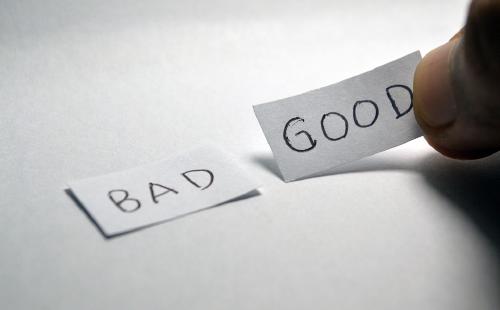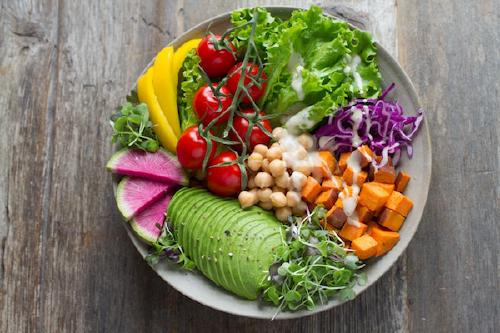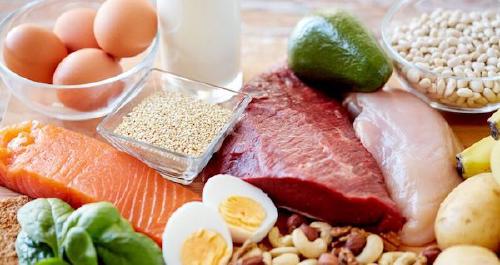You found a new diet. It’s the low-x diet.
x might be carbs. x might be fats. x might be meat. x might be processed foods.
It has a compelling story: x is now known to be the secret underlying cause of our health and obesity crisis. By reducing x, we can lose weight, reverse chronic disease and in 6-8 weeks probably definitely look like Brad Pitt in Fight Club. That fat will literally be dripping off your abs.

Some authoritative sounding studies on the detrimental effects of x are presented. Some allusion to the corporate interests involved in promoting x are thrown in for good measure.
Finally, it all makes sense! How has no-one linked all the evidence together like this before?
The Perfect Diet
You empty your cupboards, binning any source of x and stocking up on low-x and x-free products. You eat y without a care in the world. You were made to eat y.
You feel great. This is going to be it! You start to care a lot about what you eat, planning each meal carefully to avoid the insidious x.
The diet seems easy to follow. Finally, you feel like you have structure. All the conflicting diet advice you’ve heard until now is reduced down to something much more black and white. Everything is simple.

A week passes. You lose weight, and other people start noticing it too. It’s working! Everything the diet told you was true! You feel like you’ve finally found the key to weight loss—it was x all along.
The Party
A few weeks pass and you’re at a party. You’re still losing weight, but it’s slowed and you’re feeling a little less enthusiastic.
You’re caught a little hungry and suddenly there’s a big plate of x in the buffet, staring right into your soul. You try and remember those hazy facts about how x is the real cause of heart disease. But damn you’re hungry. Why does x look so good?
Alright, just a little x. It won’t hurt. Fucking hell, that tastes so good. You scoop more x up and spread it across a cracker. Oh my god. Skipping any intermediary delivery mechanisms, you just scoop a handful of x and cram it straight into your pie hole.

You begin to sweat and moan in joy. People are looking at you. You spot some liquid x, rip the cap off and pour it into your mouth, over your head, and down your shirt.
You fall back into a chair and go into an x coma. Your partner apologises awkwardly and drives you home, concerned for your mental well-being.
X-rated
When you come to, you feel sad and confused. Why couldn’t I just say no to x? I’d done so well until now. Curse you x!
You grudgingly begin to eat x again, until you’re spreading, dripping and dunking into it at each meal. 2 weeks on and you’re back to the weight you started at. Damn it, x! All that hard work reversed. I knew eating x would lead to weight gain. I’m hopeless. You supersize each serving of x with a large side of self-loathing.
Eventually, you regain focus. You’ve done it once, and you can do it again. But this time you really need to double down.
I need to eat even less x and avoid any social events where it might be on display. My partner needs to be more supportive and understanding too…
Sound familiar?
It’s a familiar story for many people, myself included.
Diet is always a controversial topic, and with the promise of perfect health and total body transformation at stake, it’s not surprising that people develop a religious fervour about different ways of eating and losing weight.
But to be fair, it doesn’t always end like this. For some people, they keep the weight off. Their low-carb or low-fat diet sticks.
And the truth is that restrictive diets of all kinds (low-carb, ketogenic, low-fat, vegan etc.) can lead people to weight loss and better health. But often not for the reasons they claim.
5 Principles Of Weight Loss
After all, many weight loss diets seem diametrically opposed. And yet people lose weight and dramatically improve their health every day, whether through Paleo or Weight Watchers. So what are some of the underlying principles that make them all “work”, particularly for weight loss?
1. Adding Structure

People find it hard to eat when nothing is technically off-limits; they become overwhelmed by choice, and then they get tired and make bad choices.
We have a limit to how many decisions we can make and how much information we can effectively filter before giving up and taking the path of least resistance (i.e. the croissant.)
Introducing restrictions and rules can help us simplify our food decisions. Having a limit on an entire food group (fats, carbs) makes meal decisions that much easier. You don’t need to have an internal debate about whether you can eat the box of Maltesers on a low-carb diet because that’s simply off limits. Breaking the rules.
The more restrictive the diet, the more structure it provides. Of course, the more rules it lays down, the more limited we feel. It’s a careful balance, and if we feel deprived for too long, we end up melting down and eating the Maltesers anyway, and usually a whole lot more on top.
It’s important to recognise that some people thrive on these kinds of restrictions—they feel like a relief and a support. Other people feel miserable.
Takeaway: Rules implicitly provide structure, which can simplify our food decisions. Anything that simplifies things for us means greater adherence: the holy grail of weight loss. Adherence—how much we stick to the diet—sounds so trivial, but it is really the be-all-and-end-all of successful dieting.
2. Caring About What You Eat

Try to change how you eat inevitably means you pay much greater attention to what you’re eating. One study found that just writing down what you eat each day correlates with double the amount of weight loss.
It’s so easy to misjudge how much you’re eating. A 2018 study by the Office for National Statistics found that Britons are consuming 50% more calories than they think they are. People chronically underreport how much they eat, often despite best intentions.
This is where the food journal steps in, providing a concrete record for us to reflect on, and a source of accountability. It doesn’t have to include every meal and every calorie: any way of tracking food will increase our awareness of how much we’re eating, and correct our habitual underestimations. Again, this is independent of diet and may be as simple as following a meal plan.
Takeaway: When we pay attention to what we eat, we have a better sense of exactly what we’re eating. We also care more about what we eat, and when we care more about what we eat, we make better choices.
3. Increasing Wholefood Intake

When we’re trying to eat healthier, we nearly always pick more unprocessed whole foods. That we should eat more whole foods is something that virtually every diet agrees upon.
It doesn’t matter whether you’re going Paleo or vegan: all eating plans worth their sodium will point you in the direction of eating more whole foods: meat, fish, nuts, salads, tubers, vegetables, fruits and whole grains.
Why does this matter for weight loss? Wholefoods are often:
- Less calorically-dense than their processed counterparts. And yet there’s more of them: you can easily bulk up meals with extra vegetables, with a very small increase—relative to volume—in calories.
- Contain more fibre
- Contain more water (particularly vegetables and fruit)
- Contain more nutrients
- And as a result are more satiating. Leading us to our next principle:
4. Improving Satiety
Satiety is probably the most under-rated concept in weight loss. In simple terms, it means how much a food fills you up and how satisfied (sated) you feel after eating it.
Let’s be clear: no diet frees us from the reality of energy balance. When we want to drop some weight, we have to expend more energy than we consume, period.
But if we prioritise foods that help us feel fuller for longer, we are more likely to spontaneously eat less. This is a huge win.
Consider, for example, 400 calories of porridge vs 400 calories of jelly beans. The porridge scores high on satiety: you’ll stay fuller for longer, and as a bonus you get to skip the brightly-coloured blood sugar rollercoaster.
By eating more fruit and veg, for example, you’ll also pad out your meals with extra fibre and water, which means a greater feeling of fullness without excess calories.
I know that when I first ate low-carb, I felt more satisfied and full from the meals I was eating. That makes sense: fats and proteins digest more slowly than carbohydrates, so are generally more satiating.
It’s not quite that clear-cut though: when scientists have attempted to rank foods in terms of satiety, the humbled boiled potato came out top of the list. That croissant you grabbed in rush did not fare well:
](/how-restrictive-diets-actually-work-the-5-principles-of-weight-loss/images/Screen-Shot-2018-08-02-at-08.55.46_hu_5a5bb24998fe6783.png)
But there is also a personal element to what makes you feel full which you need to discover for yourself.
Takeaway: If you can combine a bit of knowledge about satiating foods with your own personal preferences, you can build your diet around foods that fill you up for longer, and so spontaneously reduce your incoming energy without counting calories.
Manipulate satiety, master weight loss.
5. Increasing Protein

Along with the increase in wholefood consumption, there is another pattern that will often emerge in weight loss diets: increased protein intake.
Whether you pick a low-carb or low-fat meal plan, there’s one thing that will likely happen either way: you’ll eat more protein.
At a very broad level, your diet is a mix of carbs, fats and protein.
- If you lower your fat intake, you need to make up the deficit. Carbohydrate intake and protein intake will increase.
- If you lower your carbohydrate intake, you need to make up the deficit. Fat intake will likely increase, but so will protein.
Promoting wholefoods nearly always leads to an increase in protein. Theoretically, you could avoid this increase, but this very rarely happens, because protein is so useful in weight loss.
Why? Protein is the most satiating macronutrient. A chicken breast is going to keep you more full, on a pound-for-pound basis, than nearly any other food. And it’s pretty hard to overeat chicken breast.
Protein also has the highest thermic effect of the macronutrients, meaning that more of its caloric content is required to digest and absorb it, compared to carbohydrates or fats:
- Fats: 5-15% of energy consumed
- Carbohydrates: 5-15% of energy consumed
- Protein: 20-35% of energy consumed 🥇
As an example, if you eat 200 calories of protein, your body will use between 40-70 of those calories to absorb and digest said protein. This really adds up and makes protein king when it comes to feeling full and preserving lean mass.
Takeaway: Increase protein through any diet, and you’re likely to feel more full and so eat less. Both low-fat and low-carb diets often lead to increased protein intake.
It’s the Deficit, Stupid
All of the above help us manipulate our calorie intake in different ways. If you get enough of them working for you, you may never need to count calories.
And we haven’t even covered energy out: how much you move, how many calories you expend, which can further tip the scales in your favour.
Understanding each of the above principles can help us on the way to our weight goals, but they all serve to create one thing: a caloric deficit.
There are boring, torturous ways of creating a deficit, and there are creative, smart ways to manipulate the above principles to help you eat satisfying, delicious food, whilst losing weight.
Not convinced?
A year-long randomised clinical trial compared the difference in weight loss between people on low-carb vs low-fat diets, whilst also trying to understand if insulin secretion played a role. Their findings:
In this randomized clinical trial among 609 overweight adults, weight change over 12 months was not significantly different for participants in the HLF diet group (−5.3 kg) vs the HLC diet group (−6.0 kg), and there was no significant diet-genotype interaction or diet-insulin interaction with 12-month weight loss.
Examine.com have a more detailed analysis of this study—as well as a Q&A with its lead author, Dr Christopher Gardner—which is worth checking out.
If you eat low-carb or low-fat, it doesn’t necessarily mean you should abandon them. You’ve likely found a way of eating that suits you, and that’s a Good Thing™!
A low-fat diet often means you can eat a greater volume of food (due to the relative absence of calorically-dense fat) and that you will derive a higher ratio of your calories from carbohydrate, which can be useful if you’re quite active. And if you enjoy eating bread.
A low-carb approach often correlates with richer Mediterranean-style meals, often higher in fatty meats and dairy. Some people prefer this and find it fills them up more effectively.
Each approach can be taken too far, and you should be aware of the potential dangers of severely restricting any food group. Blood tests can easily be ordered online these days and that means you can track key biomarkers (triglycerides, LDL, CRP etc) and adjust accordingly.
Don’t want to choose? Then don’t. I tend to vacillate between low-fat and low-carb days depending on workouts, and often just eat somewhere in between. If I want to lose weight, the style of eating is irrelevant: it’s the energy balance that matters.
You Don’t Need to Restrict
The above principles—structure, care, wholefoods, satiety & protein—do not require you to restrict the types of food that eat, only how much of them you eat.
With this knowledge in hand, you can create a diet more tailored to your own needs and tastes.
Restriction is not evil and is entirely appropriate for people with medical allergies or self-discovered intolerances. As we discussed above, it’s also useful in providing some structure, but there are other less-restrictive ways to achieve the same simplification.
Restriction also works very well in the short-term. But the restrictions asked by many popular diets are often unnecessary and difficult to maintain long-term. This is why diet studies often show promising weight loss in the short-term, only for it to balance out or reverse in the longer term.
Scared about reintroducing certain demonised foods back into your life? Get real about the suggested reasons behind restrictions:
- Sugar is not the sole villain in the obesity crisis. Human bodies run on glucose—a simple sugar—and it’s an integral part of how we function. Removing added sugar in our food won’t magically fix everything. Furthermore, if you eat low-carb and find yourself craving sweet foods and then binging, add some bloody sugar into your diet. Start with blueberries and apples if honey scares you.
- You can eat bread, porridge and white potatoes whilst losing weight (and staying in optimal health.) There is nothing inherently “fattening” about carbohydrates, but if you eat too many, you will gain weight. Just as you would gain weight by eating too much fat or protein, or any mix of the three. It’s the deficit, stupid.
- Not everyone has a problem with gluten. If you do, removing it from your diet can make a big difference. But most people can tolerate it fine.
- Taking note of what our ancestors ate is a good starting point, but populations in different parts of the world ate radically different diets whilst maintaining their exemplary health. The Kitavan were remarkably healthy on a diet close to 70% carbohydrate. Compare them to the equally healthy Inuit who ate a diet that is 75% fat. It’s not the macronutrient ratios that were responsible for their health.
- Prioritising wholefood consumption is an excellent overall strategy, but it doesn’t mean that all processed food is evil.
Learn what works for you. I’d love to eat more legumes, but most of them do not agree with my stomach and make me pretty unpopular in our household. So I generally avoid them, despite their health benefits.
You have to discover—or often just remember—what foods you love. What foods keep you full and provide you with stable energy? What textures and flavours make your tongue and teeth sing?
On the other end of the spectrum, if you repeatedly eat something that makes you feel groggy and low-energy afterwards, it’s probably time to find a replacement.
Study thyself. The more you can link some basic nutritional know-how with your own tastes and experiments, the more likely you are to succeed, whatever your weight target.
If you tried Paleo or Whole30 and loved it, then stick with it! But if you get insane cravings from certain restrictions, then adapt. Use it as a template. Your colon won’t explode if you eat bread. But if you restrict too much you will eventually binge in the other direction. If adding a banana to your breakfast shake changes your life in terms of taste and energy, then you should probably take note of that.
If you thrive on structure, find ways to include it without unnecessarily restricting yourself. I tend to bundle most of my carbohydrate intake around my workout times, particularly pre-workout. There is evidence that nutrient timing is not as effective as first thought, but it gives me some pointers for building meals, whilst ensuring I can perform well.
If you’re concerned about food quality then take your own personal steps to improve that. I love bread, but your standard white sliced loaf is not a good staple to base a diet around. So I make my own sourdough. If you’re concerned about where your food comes from, check out local vegetable box schemes or other options.
Diets are harmful when they make blanket prescriptions to entire populations. It may sound alluring but it’s way too simple and creates a fear of entire food groups that is completely unnecessary and in some cases harmful.
Understand the above principles and you may not need to restrict anything at all. Care about what you eat, prioritise quality wholefoods, increase your protein intake and your movement to create the deficit that is the sole arbiter of whether or not you ultimately lose weight.
Enjoy the immense freedom and health benefits of eating a wide and varied diet. We have access to so much amazing food! Sprinkle in enough structure to support your efforts without creating a sense of deprivation. And enjoy! Eating healthy means eating delicious, life-giving food. It should feel like a step up, not a step down.
Further Reading
- What is the Best Diet? by Precision Nutrition
- Create The Perfect Meal by Precision Nutrition
- What Should I Eat For Weight Loss by Examine.com
- The Cost of Getting Lean by Precision Nutrition
- Books written by trained nutritionists and dieticians. I’ve enjoyed books by Anita Bean and Renee McGregor.
Hey you.
Interested in inner work, wisdom and learning?
